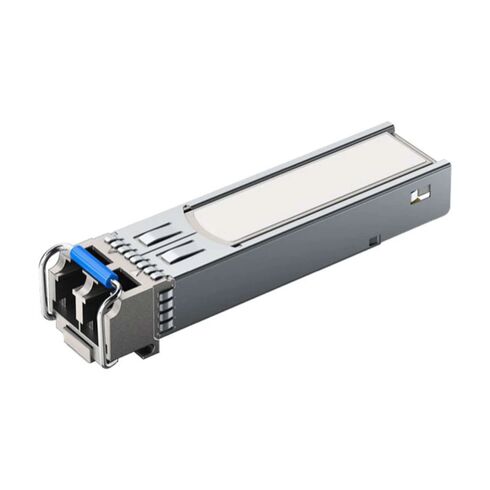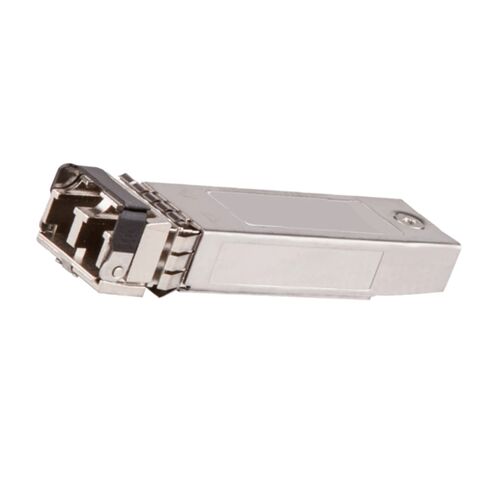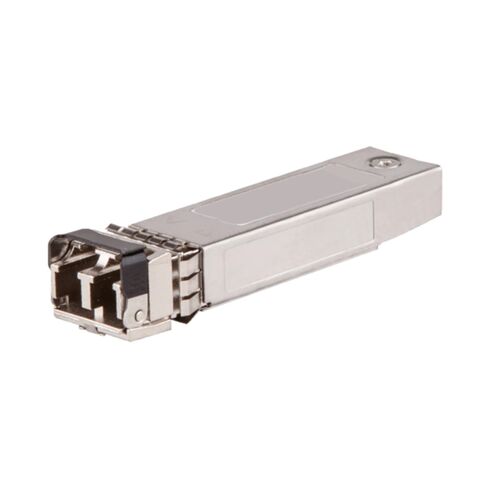J4858-61301 HPE Aruba SFP Mini GBIC LC Multi Mode Transceiver Module
- — Free Ground Shipping
- — Min. 6-month Replacement Warranty
- — Genuine/Authentic Products
- — Easy Return and Exchange
- — Different Payment Methods
- — Best Price
- — We Guarantee Price Matching
- — Tax-Exempt Facilities
- — 24/7 Live Chat, Phone Support
- — Visa, MasterCard, Discover, and Amex
- — JCB, Diners Club, UnionPay
- — PayPal, ACH/Bank Transfer (11% Off)
- — Apple Pay, Amazon Pay, Google Pay
- — Buy Now, Pay Later - Affirm, Afterpay
- — GOV/EDU/Institutions PO's Accepted
- — Invoices
- — Deliver Anywhere
- — Express Delivery in the USA and Worldwide
- — Ship to -APO -FPO
- — For USA - Free Ground Shipping
- — Worldwide - from $30
Product Specifications of HPE Aruba SFP Mini GBIC
- Type of Device: SFP (Mini-GBIC) Transceiver Module - LC Multi-mode
- Design: Plug-in Module
Networking Capabilities
Connectivity Technology
- Wired
Cabling Specifications
- 1000BASE-SX
Data Transmission Standards
- Gigabit Ethernet
Data Transfer Rate
- 1 Gbps
Maximum Transfer Distance
- Up to 1640 Feet
Expansion and Connectivity Options
Interface Availability
- 1 x Ethernet 1000BASE-SX - LC Multi-mode
Interface Type: LC
The HPE Aruba J4858-61301 SFP Mini GBIC features an Interface Type of LC. LC stands for Lucent Connector, which is a small form factor fiber optic connector. It is widely used in networking applications for its compact size and high performance.
Benefits of LC Interface
1. Compact Size
The LC interface is significantly smaller than other types of fiber optic connectors, such as SC or ST. This compact size allows for higher density installations, as more connectors can be accommodated in the same space. It is particularly beneficial in data centers or networking environments where space is limited.
2. High Performance
The LC connector is designed to provide high performance and low insertion loss, ensuring reliable and efficient data transmission. It offers excellent optical properties, helping to minimize signal loss and maintain signal integrity over longer distances.
3. Easy Connectivity
The LC connector features a push-pull latching mechanism that ensures secure and easy connectivity. It allows for quick connections and disconnections without the need for additional tools. This feature makes it convenient for network administrators to manage and maintain their network infrastructure.
4. Compatibility
LC connectors are widely used in the networking industry, making them highly compatible with a variety of networking equipment and fiber optic cables. This compatibility ensures that the HPE Aruba J4858-61301 SFP Mini GBIC can seamlessly integrate with existing infrastructure, reducing the need for additional adapters or converters.
5. Versatility
The LC interface supports both single mode and multi-mode fibers, offering versatility in network design and implementation. It allows users to choose the appropriate fiber type based on the specific requirements of their network, whether it is for short-range or long-range data transmission.
Importance of LC Interface for Users
1. Flexibility in Network Design
The LC interface provides users with the flexibility to design and configure their network infrastructure according to their specific needs. Whether they require high-speed connections over short distances or long-haul transmissions, the LC interface can accommodate both single mode and multi-mode fibers, allowing for versatile network configurations.
2. Scalability
The compact size of the LC interface enables easy scalability of the network infrastructure. As businesses grow and expand, they can easily add more connections without having to allocate additional space for bulky connectors. This scalability is crucial in dynamic environments where network requirements may change frequently.
3. Reliable and Efficient Data Transmission
The high-performance characteristics of the LC interface ensure reliable and efficient data transmission, minimizing signal loss and maintaining signal integrity. This is particularly important in critical applications where data accuracy and reliability are paramount, such as financial institutions or healthcare facilities.
4. Cost-Effective Solution
The compatibility of LC connectors with a wide range of networking equipment and fiber optic cables makes them a cost-effective solution. Users can leverage their existing infrastructure without the need for costly upgrades or replacements. Additionally, the ease of connectivity and maintenance provided by the LC interface reduces operational costs and downtime.
5. Future-Proofing
By choosing networking equipment with an LC interface, users can future-proof their network infrastructure. The LC connector is widely adopted in the industry, ensuring its availability and support for years to come. This allows businesses to stay ahead of technological advancements and seamlessly integrate new devices or technologies into their network.
Mode: Multi Mode
The HPE Aruba J4858-61301 SFP Mini GBIC operates in Multi Mode. Multi Mode refers to a type of fiber optic cable that allows multiple light rays or modes to propagate simultaneously. It is commonly used for short-distance data transmission within buildings or campuses.
Benefits of Multi Mode
1. Cost-Effective Solution
Multi Mode fiber optic cables are generally less expensive compared to single mode cables. This cost-effectiveness makes them an ideal choice for networks that require shorter-range data transmission, such as local area networks (LANs) or inter-building connections.
2. Easy Installation
Multi Mode fiber optic cables have a larger core diameter, allowing for easier installation and termination. The larger core size provides more forgiving alignment tolerances, making it easier to connect and disconnect fiber optic connectors. This ease of installation saves time and effort during network deployments or upgrades.
3. High Bandwidth
Multi Mode fibers have a larger core size, which allows them to carry more light signals simultaneously. This results in higher bandwidth capacity, enabling faster data transmission rates. It is particularly beneficial for applications that require high-speed data transfer, such as multimedia streaming or large file transfers.
4. Shorter Transmission Distances
Multi Mode fibers are designed for shorter transmission distances, typically ranging from a few hundred meters to a few kilometers. This makes them suitable for networking environments where data needs to be transmitted within a limited area, such as office buildings or university campuses.
5. Compatibility
Multi Mode fibers are widely supported by networking equipment and interfaces, ensuring compatibility with various devices and systems. This compatibility allows for seamless integration into existing network infrastructures, reducing the need for costly upgrades or replacements.
Importance of Multi Mode for Users
1. Cost-Efficiency
The cost-effectiveness of Multi Mode fiber optic cables makes them a preferred choice for users who require shorter-range data transmission. By utilizing Multi Mode fibers, users can save on installation and hardware costs compared to deploying single mode fiber optic cables.
2. Versatility in Network Applications
Multi Mode fibers are versatile and can be used in a wide range of network applications. They are commonly employed in LANs, inter-building connections, or any scenario where short-range data transmission is required. Their compatibility with various networking equipment ensures their usability in different network setups.
3. High Bandwidth Capability
The larger core size of Multi Mode fibers allows them to carry multiple light rays simultaneously, resulting in higher bandwidth capacity. This capability is crucial for applications that demand fast data transfer rates, such as video conferencing, cloud computing, or data centers handling large volumes of data.
4. Easy Installation and Maintenance
The larger core size of Multi Mode fibers simplifies the installation and termination process. The forgiving alignment tolerances make it easier to connect and disconnect fiber optic connectors, reducing the chances of misalignment or damage. This ease of installation translates into time and cost savings.
5. Scalability
Multi Mode fibers allow for easy scalability as network requirements grow. With its compatibility and support from various networking equipment, users can easily expand their network infrastructure without major disruptions or costly upgrades. This scalability is particularly valuable for businesses experiencing rapid growth or evolving network needs.
In conclusion, the HPE Aruba J4858-61301 SFP Mini GBIC with its LC interface type offers users a compact, high-performance, and versatile solution for their networking needs. The LC interface provides benefits such as easy connectivity, compatibility, and scalability, making it a valuable choice for businesses looking to optimize their network infrastructure. Similarly, the Multi Mode mode of operation offers advantages such as cost-effectiveness, high bandwidth capacity, and easy installation, making it suitable for shorter-range data transmission requirements. By considering these features and their associated benefits, users can make informed decisions when choosing networking equipment for their specific needs.













